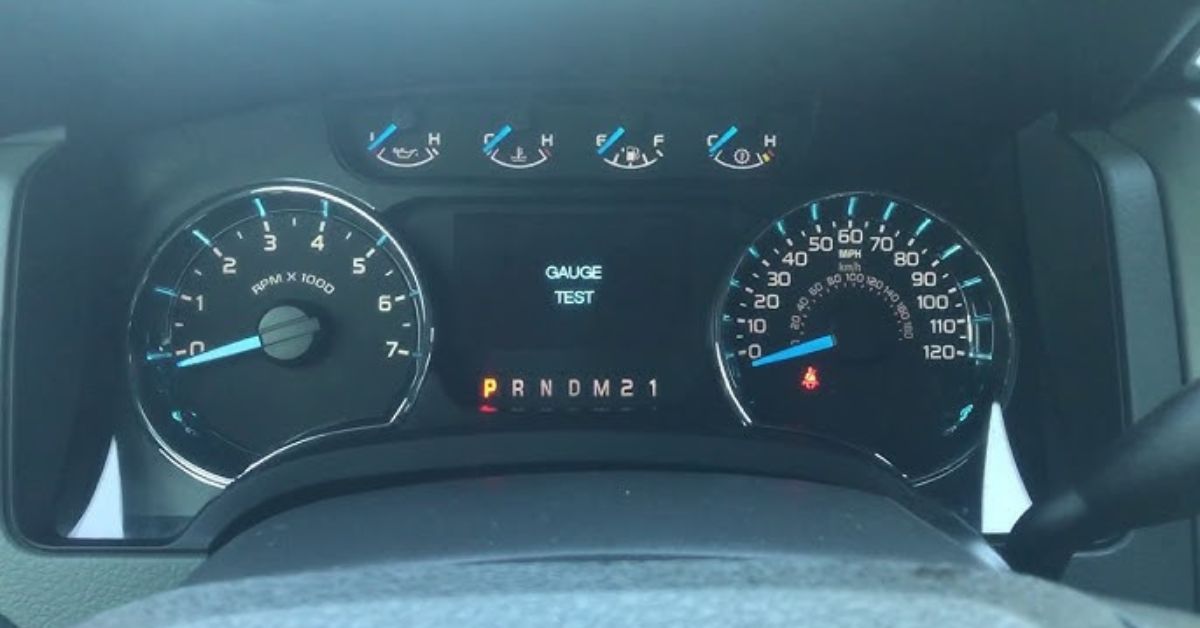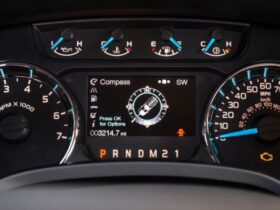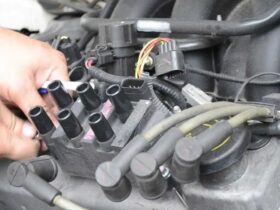The Test Mode in the Ford F150 is a built-in diagnostic feature that allows truck owners to inspect the functioning of various components, including sensors, gauges, and warning indicators, without needing an external scanner tool. This mode provides real-time data on the instrument cluster screen or odometer display, making it easier to identify any existing faults.
This hidden mode works by engaging with the electronic control unit (ECU) to detect trouble codes and display relevant information about different vehicle systems. It is a valuable tool for troubleshooting issues, especially when a check engine light or other warning indicators appear on the dashboard.
How to Activate Test Mode in a Ford F150?
Enabling Test Mode in a Ford F150 varies depending on the model year. Older models require the odometer button, while newer models (2016 and later) use the OK button on the steering wheel.
1. Using the Odometer Button (For Older Ford F150 Models)
Older Ford F150 models, such as the 2006 version, have a small button near the instrument cluster that helps activate Test Mode. If you have an older model, follow these steps:
- Insert the key into the ignition, but do not start the engine. Unlike traditional diagnostic tools, Test Mode does not require the engine to be running.
- Turn the ignition key to Accessory Mode (Position II). This will power up the instrument cluster without starting the truck.
- Press and hold the odometer button for a few seconds until a notification appears on the instrument cluster screen.
- The gauge needles will sweep to their maximum position before returning to normal. This helps reset and recalibrate them in case they were malfunctioning.
- Release the odometer button once Test Mode is engaged. You can now press the button repeatedly to cycle through different diagnostics, including:
- Battery voltage status
- Fuel system efficiency
- Transmission temperature and performance
- Coolant temperature and oil pressure
- Brake system condition
- Dashboard warning indicators and bulbs
- If there is a fault in any of these systems, the instrument cluster will display an error code that can help diagnose the problem.
It is important to avoid pressing unnecessary buttons during this process, as doing so may interfere with the self-diagnostic scan.
2. Using the OK Button on the Steering Wheel (For 2016–2020 Ford F150 Models)

For newer Ford F150 models released from 2016 to 2020, the OK button on the steering wheel activates Test Mode. The steps are slightly different but equally straightforward:
- Insert the key into the ignition switch without turning it ON. Simply inserting the key is enough to power the truck’s electrical system.
- Locate the OK button on the left side of the steering wheel. This button is used to navigate the vehicle’s onboard display menu.
- Press and hold the OK button for about 4 to 5 seconds until you see “Engineer Test Mode” displayed on the screen.
- Once activated, the gauge needles will perform a full sweep, reaching their maximum point before returning to normal. Simultaneously, all dashboard indicator lights will illuminate, allowing you to check for faulty bulbs.
- Release the OK button when the test mode screen appears. You can now use the arrow buttons to navigate through various diagnostic menus, including:
- Engine RPM (Revolutions Per Minute) to check idling speed
- Fuel flow efficiency to monitor fuel usage
- LCD screen test to check display responsiveness
- Diagnostic Trouble Codes (DTCs) to identify system errors
- Coolant and transmission fluid temperature for overheating detection
- If any errors are detected, a trouble code will be displayed on the screen, which can be referenced to determine the issue.
Unlike older models, newer F150s provide additional features in Test Mode, allowing you to scroll through different options using the steering wheel navigation buttons.
Why Should You Use Test Mode in a Ford F150?
The Test Mode feature in the Ford F150 serves multiple purposes, making it a valuable tool for troubleshooting and routine maintenance. Here are some key reasons why you might use this mode:
- Diagnosing Issues Without a Scanner Tool: Test Mode eliminates needing an OBD-II scanner by displaying trouble codes directly on the instrument cluster screen. This is particularly useful if a scanner tool is unavailable.
- Inspecting a Used Ford F150 Before Purchase: If you’re buying a used F150, running a Test Mode scan can help check for hidden faults in key systems, such as the engine, transmission, and fuel system. This ensures that the vehicle is in good condition before making a purchase.
- Troubleshooting the Check Engine Light: If the Check Engine Light comes on, running Test Mode helps determine the root cause of the problem by displaying DTC codes. This saves time by pinpointing the exact issue.
- Checking the Functionality of Gauges and Sensors: If you notice erratic behavior in your fuel gauge, speedometer, or temperature sensors, activating Test Mode can help reset and recalibrate them, improving their accuracy.
- Monitoring Transmission and Coolant Temperature: Overheating can lead to serious mechanical problems. Test Mode allows you to track real-time transmission and coolant temperatures, helping prevent potential failures.
- Verifying Dashboard Indicator Lights and LCD Display: During Test Mode activation, all warning lights and dashboard indicators illuminate, making it easy to check for malfunctioning bulbs. Additionally, the LCD screen test ensures that the display is functioning correctly.
How to Turn Off Test Mode in a Ford F150?
After the inspection, you must exit Test Mode to restore normal vehicle operation. There are two simple methods to turn it off:
1. Turning Off the Ignition
The easiest way to exit Test Mode is to:
- Turn off the ignition completely by switching the key to the OFF position.
- Remove the key from the ignition switch and wait about 5 to 6 minutes.
- Reinsert the key and return it to the ON position to restart the truck. The instrument cluster will return to normal.
2. Restarting the Truck
Alternatively, you can turn off the ignition and restart the truck. Once restarted, the instrument cluster should function as usual, and the Test Mode display will disappear.
Final Thoughts
The Test Mode feature in the Ford F150 is an essential tool for diagnosing issues and performing routine vehicle maintenance without requiring expensive scanner tools or professional assistance. It helps identify trouble codes, check engine performance, inspect dashboard indicators, and monitor transmission temperature, making it useful for mechanics and everyday drivers.
If you’re experiencing performance issues with your truck or purchasing a used F150, running a quick Test Mode diagnostic can help prevent costly repairs and ensure everything functions properly.






Leave a Reply
View Comments